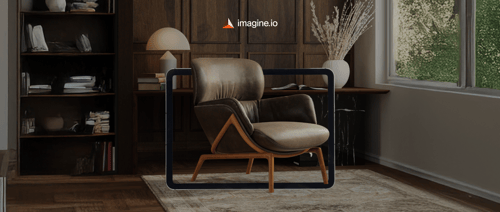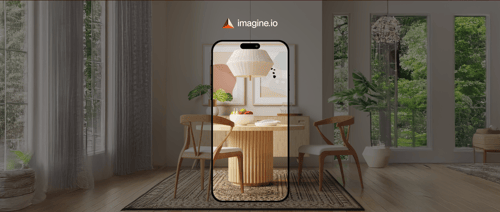If you're in retail, you know the battle for shelf space is real. Every product’s position matters—what sits at eye level, how much space it takes up, and what it’s next to can all influence whether or not it sells.
That’s where a planogram comes into play. But today’s retail teams need more than just flat diagrams. They need speed, accuracy, and visuals that sell—and that’s exactly what 3D automation delivers.
Let’s break down how 3D automation transforms planogram strategy, helps you optimize shelf layouts, and why platforms like imagine.io are reshaping how brands approach merchandising.
Get the latest updates straight to your inbox.
By clicking sign up you'll receive occasional emails from imagine.io. You always have the choice to unsubscribe within every email you receive.
First Things First: What Is a Planogram?
A planogram is a visual blueprint for shelf organization. It tells you where each product should go, how much space it gets, and how to group it alongside other items. It’s not just for aesthetics—it’s a strategic tool that drives sales, improves inventory control, and ensures store consistency.
But here’s the challenge: building and updating planograms with traditional tools can be time-consuming, expensive, and disconnected from the actual product visuals. That’s why so many brands are now shifting to 3D planograms powered by automation.
The Problem: Traditional Planograms Are Time-Consuming and Rigid
Conventional planogramming is often done in 2D using static diagrams or spreadsheet-based tools. This method presents several limitations:
- Lack of realism—no way to visualize depth, lighting, or shopper perspective.
- Manual updates—every product or layout change requires tedious adjustments.
- Siloed workflows—design, marketing, and sales teams often work in disconnected systems.
- Expensive mockups—photo-based shelf visuals require physical prototypes and long lead times.
As a result, many brands lose precious time and incur unnecessary costs while trying to keep up with merchandising demands.
Why 3D Automation is a Game-Changer for Planograms
Imagine being able to visualize your product on a shelf—not just as a flat image in a spreadsheet, but in a realistic 3D environment. That’s the power of 3D automation in planogram creation. With 3D planogram software, you can:
- Auto-generate shelf layouts based on product data and merchandising rules
- Visualize product placement in a virtual store
- Test new setups without building physical prototypes
- Collaborate across teams in real time with interactive 3D visuals
The result? Planogram automation that’s faster, smarter, and more visually accurate.
Let’s Talk About Planogram Optimization
It’s not just about putting products on a shelf—it’s about winning that shelf space. If you’re a brand trying to get into a retailer’s store, how your product looks on the shelf can make all the difference.
Planogram optimization helps you mock up exactly how your product will appear in-store, so retailers can see the value of stocking it. The goal? Stand out, look great, and get chosen.
It means:
- Putting bestsellers in high-visibility areas
- Ensuring complementary products are grouped together
- Avoiding overstocking or understocking issues
- Testing different shelf setups to see what performs best
And guess what? When you combine planogram optimization with 3D automation, you can simulate different layouts and instantly see which one performs better, without lifting a single product in-store.
The 3D Planogram Experience: What It Looks Like
So, what is the planogram experience when 3D automation is involved? It’s realistic. It’s immersive. It’s collaborative. Here’s what you get:
- True-to-life visuals: See your shelf setups exactly as customers would
- Endless variations: Test different colors, sizes, and configurations
- Faster turnaround: No waiting for physical prototypes or photoshoots
- Cloud-based collaboration: Easily share 3D layouts with your team or retail partners
This is a whole new level of merchandising strategy. And you don’t need to be a 3D expert to make it happen.
How imagine.io Simplifies Planogram Design with Smart Shelf Technology
While imagine.io isn’t a dedicated planogram software, it plays a critical foundational role in planogram automation by enabling retailers and brands to generate high-quality, scalable 3D product visuals—the very building blocks of modern visual merchandising.
Here's how imagine.io fits into the planogram ecosystem:
imagine.io makes it easy for retailers and brands to design detailed, planogram-ready visuals using 3D automation and intelligent merchandising tools. Here’s how:
-
Start with Multiple Rack Options
You can choose from a variety of rack models to match your real-world retail setup. Whether it’s a standard shelf, a wide-format rack, or a refrigerated unit, imagine.io provides customizable templates to start designing from scratch. You can even combine racks and refrigerators into one seamless visual to reflect complex retail environments.
-
Build from an Empty Rack
imagine.io lets you begin with a completely empty rack. This gives you full control over how products are arranged and displayed, rather than working with fixed presets. You can add, remove, and move products around to experiment with different merchandising strategies—perfect for teams building a planogram from the ground up.
-
Smart Shelf Technology
Using imagine.io’s smart shelf feature, you can populate your racks shelf-by-shelf, typically starting from the bottom and moving upward. Each shelf reacts intelligently as you place or remove items, making it easy to maintain balance, spacing, and alignment across your entire setup.
-
Focus and Edit Any Shelf
When you click on a specific shelf, that shelf is brought into focus—zooming in and isolating the view for precise editing. This allows you to fine-tune individual shelves without distractions, ideal for making adjustments to product placement or shelf branding at a granular level.
-
Replace Products or Clear Trays
Need to swap one SKU for another or clear out a shelf? Features like Replace and Clear Tray make it easy. Perfect for seasonal resets or testing new product combinations, you can simply select items from your prop library and place them into the viewport to build your shelf layout. It’s a quick way to keep your planogram fresh and retail-ready.
-
Customize Shelf Branding
You can upload custom branding elements such as logos, promotional stickers, or campaign graphics directly onto shelves and racks. This helps visualize endcaps, featured displays, or branded refrigerator units—making your planogram more realistic and campaign-ready.
-
Change Product Colors and Flavors
Got multiple versions of your product—like Pepsi Original, Diet, and Lime? Instead of creating separate photos for each one, you can easily swap colors, labels, or packaging right in the 3D render. Even better, all these variations can be handled in a single automation project. That means less effort, faster output, and a full lineup of SKUs ready to present to retailers.
-
Generate Fully Colored, High-Resolution Renders
Once your shelf layout is ready, you can export fully rendered, high-resolution images that are ideal for use in planogram software, internal presentations, or retail pitch decks. These visuals are photorealistic, consistent, and ready to plug into tools like Blue Yonder, Repsly, or even e-commerce platforms.
Real-World Example: Streamlining a Seasonal Product Launch
Imagine a furniture brand preparing a spring rollout of new wingback chairs and dining setups. Using imagine.io, the visual merchandising team quickly renders all product variations (patterned, plain, light wood, dark finishes) and drops those into a planogram tool.
Within a week, the brand has:
- Shelf-ready visuals for buyers and store planners
- Lifestyle setups for e-commerce
- Campaign content for social and paid media
All without a single photo shoot or physical prototype.
The Bigger Picture: Smarter Planograms, Better Business Outcomes
The true value of planogram automation lies not just in visuals, but in strategy. Brands that leverage 3D tools:
- Make faster, data-driven decisions
- Reduce time and costs across departments
- Deliver cohesive retail experiences, online and offline
And with platforms like imagine.io, even small and mid-size brands can compete with big players—without massive budgets or design teams.
Final Thoughts: Make 3D Your Competitive Edge
Planograms are no longer just operational tools—they’re strategic assets that influence customer behavior, brand perception, and business outcomes.
In a market where speed, accuracy, and visual quality matter more than ever, 3D automation is the future. imagine.io empowers retail teams to embrace that future by providing scalable, cost-effective 3D content that enhances planogram efficiency and fuels omnichannel success.
Ready to simplify your retail content creation and supercharge your merchandising strategy? Book a demo with imagine.io and see how 3D content can elevate your shelf impact—without the heavy production costs.


.gif?width=1296&height=1296&name=Untitled%20design%20(8).gif)



.png?width=500&name=How%20to%20Add%20a%203D%20Product%20Configurator%20to%20Your%20WordPress%20Website%20(Complete%20B2B%20Guide).png)
















%20(1).png?width=500&name=Why%20Exploded%20Mattress%20Views%20Matter%20(And%20How%20to%20Generate%20Them)%20(1).png)
.png?width=500&name=Best%20Shopify%20Product%20Configurator_%20How%20to%20Choose%20the%20Right%20One%20(2).png)
.png?width=500&name=Why%20Exploded%20Mattress%20Views%20Matter%20(And%20How%20to%20Generate%20Them).png)



.png?width=500&name=Best%20Shopify%20Product%20Configurator_%20How%20to%20Choose%20the%20Right%20One%20(1).png)







.png?width=500&name=How%203D%20Rendering%20Can%20Make%20or%20Break%20Your%20Industrial%20Design%20Pitch%20(1).png)








%20with%20Digital%20Twins%20and%203D%20Visualization.png?width=500&name=Optimizing%20Your%20Digital%20Asset%20Management%20(DAM)%20with%20Digital%20Twins%20and%203D%20Visualization.png)




.png?width=500&name=Styling%20Home%20Decor%20for%202025_%20From%20Global%20Influences%20to%20Playful%20Personalization%20(1).png)

